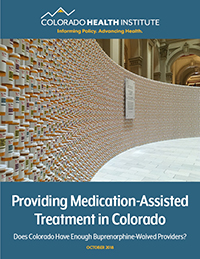Federal Action on Opioid Epidemic Could Increase Access to Medication-Assisted Treatment
Last week, President Trump signed a new law aimed at addressing the opioid epidemic: The Substance Use-Disorder Prevention that Promotes Opioid Recovery and Treatment for Patients and Communities Act, or SUPPORT Patients and Communities Act.
This bipartisan effort addresses multiple facets of the opioid epidemic. It expands access to treatment, creates incentives to build the workforce, and identifies new educational initiatives for healthcare providers, among other changes. (Read the complete details in this summary).
 The SUPPORT Patients and Communities Act also increases access to medication-assisted treatment (MAT) — medications used to treat opioid dependence – by expanding who can prescribe those medications, increasing the number of patients certain prescribers can treat immediately upon receiving their waiver, and reducing barriers to prescribing MAT via telemedicine.
The SUPPORT Patients and Communities Act also increases access to medication-assisted treatment (MAT) — medications used to treat opioid dependence – by expanding who can prescribe those medications, increasing the number of patients certain prescribers can treat immediately upon receiving their waiver, and reducing barriers to prescribing MAT via telemedicine.
There isn’t a silver bullet fix for the opioid epidemic, but MAT is one tool that can be used to combat the large increase in the number of opioid overdoses.
Buprenorphine is one of three types of MAT, and is a lifesaving treatment that blocks the effects of opioids, decreases cravings for other opioids, and suppresses symptoms of withdrawal.
However, there are restrictions around who can prescribe buprenorphine in a doctor’s office, and how many patients they can treat at any given time.
Qualified practitioners need to receive training and apply for a special DEA X-waiver in order to prescribe buprenorphine for the treatment of opioid dependence. In the first year, qualified providers can treat up to 30 patients at one time. After that medical doctors and doctors of osteopathic medicine can treat up to 100 patients in the second year, and 275 after that if they apply for additional waivers.
Prior to the SUPPORT Patients and Communities Act, physicians, nurse practitioners, and physicians’ assistants were eligible to receive a DEA X-waiver. The new law expands the definition of qualified practitioners to include clinical nurse specialists, certified registered nurse anesthetists, and certified nurse midwives for the next five years.
The law also allows providers who are board certified in addiction medicine or addiction psychiatry to being immediately treating 100 patients at a time.
As this legislation and other policy efforts continue to reduce barriers to getting MAT and into recovery, it is important to understand how many buprenorphine-waived providers there are in Colorado, and how many of them are prescribing.
New Analysis of MAT in Colorado
So what is the status of MAT in Colorado before the SUPPORT Patients and Communities Act’s changes take effect? CHI has completed a new analysis to determine how many providers in Colorado have received their waiver, and prescribed buprenorphine during 2016 and 2017.
As of December 2017, there were 702 waived providers in Colorado: 578 physicians, 85 nurse practitioners, and 39 physician assistants.
Using data from the Colorado Prescription Drug Monitoring Program provided by Maria Butler, an epidemiologist at the Colorado Department of Public Health and Environment, and a list of Colorado providers who have their waiver provided by the Substance Abuse and Mental Health Services Administration, our analysis seeks to answer the following questions:
- Does Colorado need more providers who are authorized to prescribe buprenorphine?
- Does Colorado need its authorized providers to prescribe buprenorphine more often?
Our conclusion is that the answer to both questions is yes. We found that:
- Only about a quarter of the 47,000 Coloradans with an opioid use disorder were prescribed buprenorphine, a medication commonly used to treat the disorder, in their medical provider’s office in 2016 and 2017.
- If all authorized providers wrote the maximum number of buprenorphine prescriptions they were allowed to, they could treat nearly 40,000 Coloradans.
- Only 8 percent of providers who can prescribe buprenorphine are in rural counties.
A policy framework for addressing the opioid crisis includes a pillar for expanding access treatment, including medication-assisted treatment. The SUPPORT Patients and Communities Act at the federal level tackles one piece of the framework by increasing the number of providers who can prescribe buprenorphine in a provider’s office. This will hopefully bring MAT providers to more Coloradans who need and want it.
But reducing other barriers to prescribing buprenorphine in a doctor’s office or clinical setting is an important step toward expanding patient access to this type of treatment.
To read more about the current landscape of buprenorphine-waived providers in Colorado and the barriers they face to prescribe buprenorphine, read CHI’s new analysis.
Want more information about health and health policy in Colorado? Subscribe to our newsletter or find CHI on Facebook and Twitter.
Related Blogs and Research
- Providing Medication-Assisted Treatment in Colorado
- Miles Away From Help: The Opioid Epidemic and Medication-Assisted Treatment in Colorado
- The Opioid Epidemic is Officially a National Public Health Emergency. What Does That Mean For Colorado?
- Five Still Standing: Remaining Opioid Bills Moving Through the Capitol
- How to Respond to the Opioid Crisis

